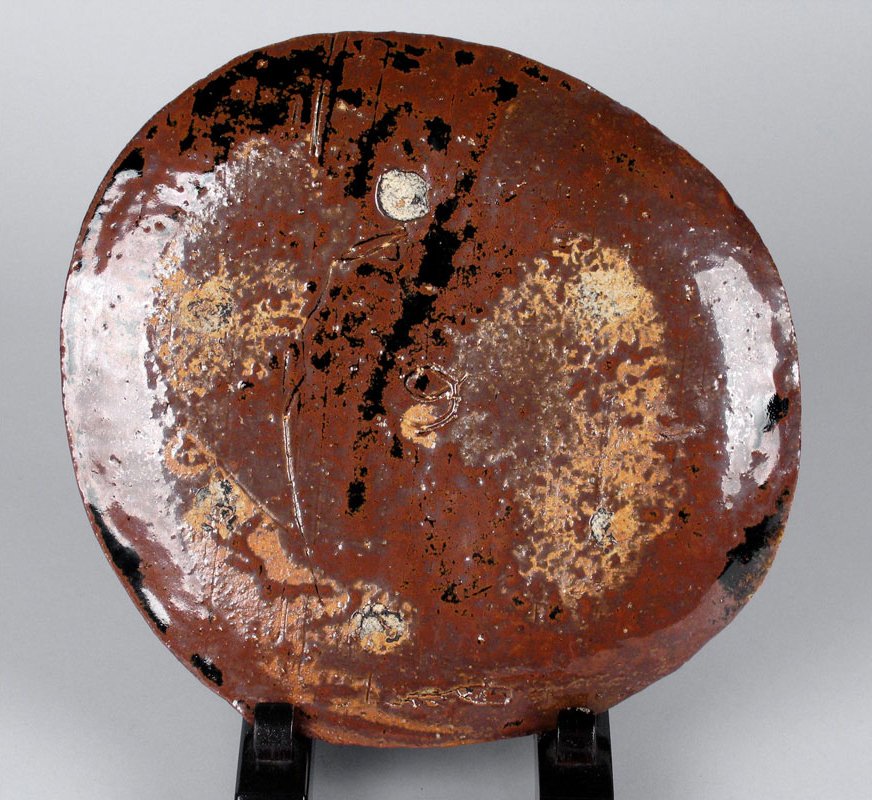POST WAR & CONTEMPORARY
ISAMU NOGUCHI, 1952 STONEWARE FACE ABSTRACTION
Plaque in a rounded form, the surface incised with a haunting abstraction of a human face. Of Shigaraki type stoneware with an applied black iron-oxide glaze. Signed on the reverse with an incised signature by the artist: No (Isamu Noguchi, 1904 – 1988). Showa 27 or 1952.
With a double tomobako or original box, the outer box lacquered and the inner paulownia wood box signed on the exterior of the box in katakana: No (Isamu Noguchi) and with an applied paper label inscribed: Isamu Noguchi Jin-men Mon-zara or Isamu Noguchi’s Human Face Form Plaque; and on the reverse of the lid signed in English script: Isamu Noguchi, 1952.
Born in Los Angeles, Isamu Noguchi was the child of a Japanese poet and an American writer, Noguchi Yonejiro and Leonie Gilmour. While his childhood years were spent in Japan, Noguchi returned to the United States to attend high school. After graduation, he entered Columbia University in New York, intending to study medicine. However, a deep inclination for the arts led him to abandon the university in order to study sculpture. This was supported in 1927 by a Guggenheim fellowship, which allowed him to travel to Paris to study for two years with the modernist sculptor Constantin Brancusi. After he returned to New York, he supported himself with private commissions for portrait sculptures and he began to develop his own abstract artistic idiom. Also in the 1930s Noguchi traveled to China, Japan and Mexico. During the Pacific War, he was interned with other Japanese-Americans in a war relocation camp in Arizona. With the end of the war, Noguchi turned again to his Japanese heritage and made several visits to Japan. There, his interest in Japanese ceramics and gardens deepened and formed a lasting influence on his later work. He remains famous for his abstract sculptures in various media, including ceramics, wood, stone and cement.
Late in 1951, as Louise Cort relates in Isamu Noguchi and Modern Japanese Ceramics, Isamu Noguchi returned again to Japan and married the movie star and actress Yamaguchi Yoshiko. They moved into a humble folk art style cottage on the property in Kita Kamakura belonging to the famous potter Kitaoji Rosanjin. For several months there in 1952, Noguchi worked in clay for the last time in his life. The pieces produced were exhibited that fall in his first solo exhibition in two years. Of the 120 new works by Noguchi in the exhibition, 119 were ceramics. The catalogue from this exhibition hosted by Mainichi Shimbun and held at the Museum of Modern Art in Kamakura from September 23 – October 19, 1952, lists in the section of Shigaraki no Sara or Shigaraki (Ware) Plates, number 30 as: Kuro-yü or Black Glaze, almost certainly this plaque.
Louise Cort writes: “In an interview with Noguchi late in 1952, a journalist noted the many Japanese motifs in his work and asked, ‘Just what is it that you find appealing about Japan?’
“‘It’s the earth,’ Noguchi answered, the coarse earth which only Japanese people have. It is not in America. I am drawn to the skin of the pottery, the Japanese earth’…
“But ‘the coarse earth’ he associated with Japan was not just a matter of pottery materials and techniques; it was also a medium colored by the larger complex of values that Noguchi associated with Japanese culture including a rustic aesthetic, an ideal closeness to nature, and a rich craft tradition.” (As above, pages 39 – 40)
For another of his face motif pieces from the Kita Kamakura period, c.f. Isamu Noguchi and Modern Japanese Ceramics, page 60, figure 1.52.
A haunting double face stares out from this earthen plate, formed from two primitive ovals joined to share a common nose and a half-smiling mouth. The left eye seems smaller, half-closed, the right large and aware. The features look at us through an elemental black and brown iron-oxide glaze. It is as if Noguchi were suggesting a relationship of two related halves, perhaps female and male, and the intimate connection between humanity and nature through the medium of clay and earth.
A rare and powerful example of Noguchi’s work from this early post-war period.
Isamu Noguchi, 1952 Stoneware Face Abstraction
Artist Name: Isamu Noguchi
Period: Showa Post War
Mediums: Ceramic
Origin Country: Japan
9 ½” high x 10” wide x 7/8” deep
This piece is no longer available.



